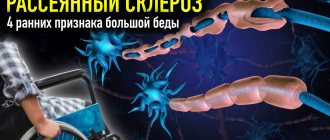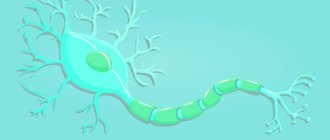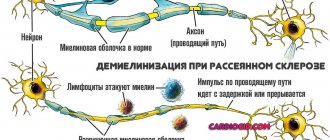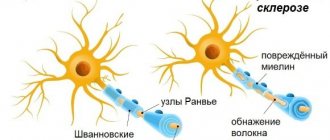Multiple sclerosis (MS) is a neurodegenerative disease that occurs due to various environmental and genetic factors.
Genetics is a branch of biology that deals with the study of the structure and function of genetic material (“genes”). Inheritance is the transfer of genetic information from generation to generation. Many people wonder whether multiple sclerosis is inherited by a child?
Hereditary predisposition increases the risk of developing MS
It has long been thought that a child of a mother or father with MS has a higher risk of developing the disease. In Central Europe, the risk of developing MS in the general population is 0.1%.
About 1 in 1,000 people develop MS each year. About a third of them require constant care and drug intervention.
Homozygous twins whose mother has MS have a 25% higher risk of developing the disease than others without a family history. Grandchildren have a 3% risk of developing MS, which is 30 times higher than in the general population. But this figure also shows that there is a 97% chance of not developing multiple sclerosis in your lifetime. Therefore, risk factors can be inherited by a child, but this does not mean that they will necessarily lead to multiple sclerosis.
Already in the 70s of the last century, a connection was discovered between multiple sclerosis and genes that control the function of immune cells (lymphocytes). These genes are called HLA genes. Patients who have HLA-DR2 markers in their genes develop MS in 0.4% of cases.
Is multiple sclerosis inherited? Development factors, symptoms and treatment of the disease
The exact causes and mechanism of development of multiple sclerosis have not been clarified to this day. At the moment, researchers know the factors influencing the likelihood of developing the disease and its course, but the final picture has not yet been obtained. And yet, some facts about the development of sclerosis and the role of heredity in this process can be considered confirmed.
Causes and risk factors
Multiple sclerosis is an autoimmune disease in which immune cells attack tissues of the same body, in this case nervous tissue.
Note: Research shows that genetic predisposition plays a major role in this.
In this case, the disease does not occur on its own - genetically “prescribed” autoimmune reactions develop only under the influence of provoking factors, such as:
- Viral and bacterial infections . Protracted infections provoke the constant production of immune cells, which begin to destroy nerve tissue. The so-called slow infections – with a long latent period – are especially dangerous. They are caused by measles, rubella, herpes, human papillomaviruses, and retroviruses.
- Vitamin D deficiency . It is noted that residents of regions remote from the equator and poorly lit are susceptible to multiple sclerosis. This is due to the fact that under the influence of ultraviolet radiation, vitamin D is synthesized in the body, which prevents the development of sclerosis.
- Smoking . Smoking significantly increases the risk of developing the disease. At the same time, the patient’s refusal to smoke slows down the course of the disease.
- Stress . Severe physical or psychological stress can trigger an autoimmune reaction in the body.
- Uric acid level . Studies show that patients have low uric acid levels. This suggests that uric acid somehow prevents the development of the disease, but it is not yet known exactly how.
Important: There is a common misconception that the hepatitis B vaccine can cause multiple sclerosis. However, recent studies refute this claim.
Genetic factors in the development of the disease
A 2011 study identified 57 genes responsible for the disease..
Most of the identified genes control the body's immune reactions, which confirms the theory of the autoimmune nature of multiple sclerosis.
Genes that influence the development of the disease are localized on chromosome 6 and belong to the so-called major histocompatibility complex, which is responsible for the ability of immune cells to recognize and attack foreign objects.
A genetic malfunction under external influence triggers an autoimmune reaction mechanism, and lymphocytes begin to attack the body’s own tissues. The genes responsible for the disease, although to a lesser extent, are also localized on the 7th and 18th chromosomes.
Multiple sclerosis is influenced by the myelin basic protein gene on chromosome 19 , but its association with the disease is observed only in residents of Finland.
Is it inherited?
Is multiple sclerosis inherited from children? This type of sclerosis is a partially inherited disease. The patient's relatives from the first to third degrees are at risk.
Currently, about 20% of all cases of multiple sclerosis are familial cases . Among the patient's relatives, the risk is distributed as follows:
- identical twins – 25-30%;
- fraternal twins – 2-5%;
- non-twin brothers and sisters – 2-5%;
- parents and children – less than 2%.
Attention: with increasing degree of relationship, the risk of developing multiple sclerosis decreases.
Symptoms and diagnosis
Symptoms are varied and individual for each patient. This makes it difficult to make a diagnosis and determine the degree of disability.
For the most accurate diagnosis today, the EDSS (Expanded Disability Status Scale) scale is used - an expanded scale for determining the level of disability. The peculiarity of EDSS is that it evaluates the state of seven functional systems of the body simultaneously.
- Visual – visual acuity is assessed.
- Pyramid – assesses the tone and strength of the muscles of the limbs.
- Stem – the work of the brain stem, which is responsible for receptors, eye muscles, swallowing and salivation functions, and chewing muscles, is assessed.
- Cerebellar – assesses coordination, sense of balance and the patient’s sense of the body in space.
- Sensitive - the patient’s ability to feel touch, temperature, tingling and other external influences is analyzed.
- Pelvic – the functioning of the pelvic organs, bladder and bowel function is assessed.
- Cerebral – the patient’s cognitive abilities and changes in the emotional background are analyzed.
Help: when assessing each of the seven systems, a certain number of points is assigned - the more severe the symptoms, the more points. The results are then interpreted and a total score is given.
The interpretation is as follows:
- 0 points – no abnormalities were identified, the patient is completely healthy.
- 1 point – deviations in one of the systems that are not apparent externally.
- 2 points – minimal disability, not causing serious discomfort to the patient.
- 3 points – moderate disability in one or minimal in three or four systems; therapy at home is possible.
- 4 points – increasing disability while maintaining an active lifestyle; the need for outpatient treatment. The main criterion is the patient’s ability to walk 500 meters independently.
- 5 points – outpatient treatment; independent walking 200 meters.
- 6 points – walking 100 meters or less with the help of a cane.
- 7 points – walking is almost impossible even with the use of assistive devices; need to use a wheelchair.
- 8 points – lack of movement while maintaining the ability to care for oneself.
- 9 points – loss of self-care skills, constant stay in bed.
- 10 points – death.
The main diagnostic methods include studying the patient's complaints and taking an anamnesis. To clarify the diagnosis and identify the localization of sclerotic plaques, magnetic resonance imaging (MRI) using a contrast agent is used. As an additional diagnostic method, analysis of cerebrospinal fluid for the level of leukocytes and lymphocytes is used.
More information about diagnostics is described in this video:
Treatment and prevention
Treatment of multiple sclerosis is aimed at stopping exacerbations and reducing the activity of autoimmune processes. For exacerbations, synthetic glucocorticosteroids and methylprednisolone are used . During remissions, drugs such as interferon beta, glatiramer acetate and teriflunamide are used to prevent new exacerbations.
These drugs belong to the group of DMTs - drugs that change the course of the disease.
They have an immunomodulatory effect, reducing the activity of T-lymphocytes and suppressing their proliferation; They also reduce the rate of migration of immune cells across the blood-brain barrier, thereby preventing immune attack on the white matter of the brain. How effective is stem cell treatment? Read here. Is it possible to use folk remedies for multiple sclerosis? Find out by clicking on the link.
Modern treatment methods cannot make the disease reversible , but they can stop its progress and improve the patient’s quality of life.
To reduce the likelihood of its development, it is recommended to monitor risk factors, avoid severe stress if possible, quit smoking (lead a healthy lifestyle) and do not neglect preventive examinations.
Conclusion
Multiple sclerosis is a disease with a complex development mechanism that has not yet been fully studied. However, every year, research into this disease brings new results, and one can hope for the development of effective therapy and preventive measures in the near future.
, please select a piece of text and press Ctrl+Enter.
Source: https://inBrain.top/bolezni/skleroz/vidy-sk/rasseyannyj/peredaetsya-li-po-nasledstvu.html
Gene factor for disease development
MS itself is not a hereditary disease , however, due to many years of research, a clear correlation was found that relatives are actually much more likely to develop this disease than those who did not have it in their family.
This is confirmed by the figures - 2% among the “hereditarily healthy” and up to 10% among people with sick relatives.
Is there a special gene for MS?

For example, in the USA, an increased connection between the appearance of multiple sclerosis and the presence of antigens B7, DR2 in patients was noticed, in Central Russia - with the A3 and B7 loci, in Siberia - A1, A9, B7.
In peoples living in Europe with this disease, the haplotype DR2 (DW2) DRB1*1501 - DQA1*0102 - DQB1*0602 of the HLA class II system is most often determined.
Factors that can lead to mutations in genes include:
- A mutation in T-lymphocytes, when some of them cease to perform a protective function and begin to destroy the immune system.
- Bad habits - alcohol, smoking, drugs.
- Frequent viral, infectious and fungal diseases.
- Constant stress.
Genetic MS can occur in the following scenarios:
- Relapsing-remitting multiple sclerosis. It is characterized by rare periods of exacerbations, with the possibility of full recovery with proper treatment.
- Secondary progressive sclerosis. With this form, the symptoms worsen constantly, but with fairly long periods of remission.
- Primary progressive sclerosis. Rare periods of remission. The patient's condition is permanently deteriorating.
- Sclerosis that progresses with exacerbations is a constant deterioration of the condition, there are practically no periods of remission.
Genetic predisposition as a cause of the development of multiple sclerosis:
Find out more about multiple sclerosis:
- causes and consequences of the disease;
- the first signs and symptoms of the disease;
- methods of diagnosing the disease, including MRI diagnostics;
- forms and variants of the course of pathology;
- diseases similar to MS;
- pregnancy and childbirth in the presence of this disease.
Is multiple sclerosis inherited?
When a loved one or yourself is given a serious diagnosis of multiple sclerosis, there is a natural desire to learn as much as possible about the disease. Where did it come from, what is the reason, what consequences does it have for life?
Since the pathology usually occurs during reproductive age, the question is urgent: is multiple sclerosis inherited? Is it inherited genetically to the child from the mother or through generations? Let's try to figure out what factors contribute to the occurrence of the disease.
Causes of the disease
Multiple sclerosis is a demyelinating autoimmune disease that is chronic in nature, in which the human immune system produces special antibodies that consistently destroy nerve cells by affecting the myelin layer of nerves.
The cause of this disease is the simultaneous confluence of certain conditions or factors. These conditions can be divided into:
Common ones contribute to the appearance of the disease and there may be several of them. These include:
- Belonging to the European race.
- The presence in the family of a person suffering from multiple sclerosis, and this person is a close blood relative.
- Belonging to the female gender.
- Changes in living conditions.
Direct factors are specific and are identified during diagnosis. These include:
- The effect of certain viruses and bacterial infections on the body, such as the herpes virus or streptococcal infection.
- Chronic processes in the body.
- Diet and daily routine.
- Physical and emotional stress.
- Hereditary predisposition.
- Taking oral contraceptives increases the risk of multiple sclerosis.
Inheritance of multiple sclerosis
Hereditary predisposition increases the risk of developing the disease. This does not mean that a person will certainly get sick. The disease is possible when several of the conditions described above occur simultaneously.
Genetic studies have not confirmed the linkage of the disease to the gene. That is, it is not multiple sclerosis itself that is inherited, but a predisposition to it. It has also been found that certain genes influence the production of enzymes called myelin proteins, which contribute to the onset of the disease.
Risk level for multiple sclerosis
There is a hypothesis that hereditary predisposition is associated with the presence of certain genes and genetic polymorphism.
This is confirmed by research in the field of genetics and a tendency towards a decrease in the occurrence of danger among relatives of those who already have multiple sclerosis, depending on the decrease in relationship.
Scientists have found that the disease occurs 30 times more in families where there is a sick relative.
The greatest risk of developing multiple sclerosis is among blood brothers and sisters, it ranges from 2 to 5%; for parents of sick children the percentage is lower.
If one of the parents has multiple sclerosis, the child’s risk of getting the disease is increased by only 2% compared to other people.
Women are more susceptible to this disease than men. In identical twins, the probability is between 20 and 35%. In fraternal twins, the risk will be much lower, about 5%. This is due to the fact that fraternal twins have different genotypes. It is familial sclerosis that appears in 10% of all cases of the disease.
From all of the above, we can conclude that multiple sclerosis is still inherited. It must be remembered that only a predisposition to the disease is inherited, which slightly increases the likelihood of its occurrence.
Planning pregnancy with multiple sclerosis
When planning pregnancy with multiple sclerosis, factors such as:
- Current ability to work, as well as future.
- The ability of parents to be responsible for their children.
- Support from friends and immediate family.
- Financial possibilities and their stability.
It is impossible to predict the development of multiple sclerosis, so it is impossible to ascertain a couple’s ability to independently cope with the peculiarities of caring for and raising children. However, this disease is not a contraindication to pregnancy and childbirth.
In this area, a study has been conducted of the influence of pregnancy on the development of sclerosis. It showed that exacerbations occur much less frequently during pregnancy. Also, the disease is not necessarily inherited from the mother to the child.
Before conceiving a child, you should contact a reproductive center, as well as a medical institution, for advice on treatment and prevention methods during exacerbations of MS, in order to determine which ones are safest to use during pregnancy. Also, several months before conception, it is necessary to stop using immunomodulatory therapy, which will need to be continued after the birth of the heir.
No information was found on decreased fertility, an increased risk of miscarriages, the appearance of congenital pathologies, or the birth of a stillborn child with a disease such as multiple sclerosis.
Source: https://oskleroze.ru/rasseyannyy-skleroz/peredaetsya-li-rs-po-nasledstvu
Psychology moves by touch
Original psychologists from different countries came to the same conclusion: people of the same psychotype suffer from multiple sclerosis.
Patients in neurological hospitals are people experiencing chronic stress for a long time. A traumatic situation is accompanied by increased anxiety. At the same time, acute stress is not as dangerous as chronic and long-term stress.

People are at risk of developing multiple sclerosis if they are too compliant. Under the mask of softness lies an abnormally increased need for attention and love. More often this happens when a person does not receive enough love in childhood. When faced with reality, such a “disliked” adult tends to blame himself for everything, despite the circumstances. Figuratively speaking, instead of wounding the enemy, such a person prefers to inflict a wound on himself.
Evidence that these behaviors and mindsets predispose one to multiple sclerosis exists only in the form of statistics. You can’t argue with statistics, as well as with the fact that character is definitely inherited.
Psychologists say that when it is impossible to adequately adapt to reality, a person builds up a “shell”, suppressing his own natural reactions.
Relatively speaking, the one who under any circumstances wears a “mask” of restraint and impenetrability is at greater risk than the one who bangs his fist on the table or sobs sincerely and loudly.
Suppressing oneself, “pushing” any emotions inside always leads to illness - if not to multiple sclerosis, then to hypertension. Unreacted emotions gradually lead to the fact that a person begins to blame others for his troubles, and this is a new round of illnesses.
The study of the influence of emotions is the work of physiologists, and it is actively being researched.
Multiple sclerosis - symptoms, causes, diagnostic methods, treatment, prognosis
Multiple sclerosis is a diagnosis that is not so common in our latitudes. Many, hearing it for the first time, believe that it is associated with absent-mindedness and memory problems.
In fact, everything is completely different - this is a problem of the autoimmune system, which has nothing to do with senile sclerosis.
The initial stages of the disease are practically asymptomatic, and their first manifestation can occur within a few years.
Multiple sclerosis is diagnosed in women 2-3 times more often than in men. The age at which the disease manifests itself is quite young – from 15 to 40 years, i.e. reproductive. When planning a pregnancy, women pay special attention to their health. This is largely why, when a diagnosis is made to someone close to you, relatives are interested in the issue of heredity.
"Trigger" hypothesis
This hypothesis is being discussed more and more. It is believed that many human and animal viruses are somehow capable of triggering an immune system attack on the body's own myelin, which envelops the axons of nerve cells. Influenza and measles viruses are especially suspicious in this regard. It's all about the similarity of the structure.
Myelin is essentially a membrane consisting of many layers of lipids or biological fats and proteins. During its formation, myelin wraps around the axon like a multilayered spiral. There are practically no gaps between the turns of the spiral on the mature myelin sheath. Lipids and proteins are “stacked” so tightly that there is no room left for cytoplasm.
If you look at the structure of the measles and influenza viruses, they are strikingly similar to myelin. It's no surprise that the immune system gets it wrong.
The American organization MRF or The Myelin Repair Foundation is studying the relationship between viruses and myelin, as well as the possibility of restoring the nerve sheath.
Scientists are looking for ways to “teach” stem cells to turn into myelin, directing them to sites of damage. The results are still modest, but they give hope to many disabled people.
It's useful to know whether multiple sclerosis is inherited
Multiple sclerosis begins with damage to conducting nerve fibers in any area of the central nervous system. The immune system fails to cope, resulting in a malfunction of the brain or spinal cord.
Problems with coordination, impaired sensitivity, a sharp decrease in vision - all these are manifestations of multiple sclerosis.
There is no single reason for the occurrence of this disease; many factors and changes that occur in the human body have an influence.
Causes
There are general and direct causes that contribute to the occurrence of multiple sclerosis:
- The European race is at risk.
- There is a chance of getting sick if one of your blood relatives in the family has already had this disease.
- The disorder most affects women.
- Moving to another natural area, sudden climate change.
Provoking environmental factors:
- Viral and bacterial diseases in chronic form (for example, herpes).
- Great physical and emotional stress.
- Hereditary predisposition.
- Lifestyle, nutrition.
- Female birth control pills may be one reason.
- Deficiency of vitamins and other microelements.
- At risk are people who have received a dose of radiation and chemical poisoning.
Is there a genetic predisposition to multiple sclerosis?
If your family already has or has had multiple sclerosis, your risk of getting the disease increases. This does not mean that the disease will definitely come. Other reasons, along with heredity, can also serve as the impetus for the onset of the disease.
Long-term research shows that the disease is not transmitted through a gene; a person inherits the risk of developing such a disorder, and not the disease itself. These same studies have shown that some of our genes contribute to the synthesis of myelin in the body, which is the impetus for disease.
The human body is constantly exposed to various bacteria and microbes, to which it reacts differently. This natural reaction is genetically determined. Therefore, it cannot be ruled out that the same disease in close relatives will have the same course.
What is the risk of multiple sclerosis in relatives?
Statistics show that multiple sclerosis affects 30 times more people from families with a history of the disease. The risk is greater if a very close relative is sick: parents, sisters and brothers. The disease may not affect you if the sick person is only a distant relative.
In the risk group, blood brothers and sisters, from 2% to 5%, parents may not get sick. If one of the parents is sick, the child has a risk of getting multiple sclerosis; the percentage risk reaches 2%.
In twins, if they are identical, the risk of getting sick reaches 35%, and if they are fraternal, then only up to 5%. Fraternal twins usually have different genotypes. If we take all cases of multiple sclerosis, the following picture emerges: 10% of all patients have close relatives who have already encountered this disorder.
Females are more vulnerable to this disease than males . It was previously noted that women between 20 and 40 years of age are most susceptible to multiple sclerosis. Today there are already other statistics according to which the disease affects people from the age of 15. Up to the age of 50, females are more vulnerable to this disease than males.
Distribution of morbidity depending on climatic conditions
It is believed that multiple sclerosis progresses in countries with temperate climates, where people do not get enough vitamin D. Out of 100 thousand people, in northern countries, where daylight hours are short, from 50 to 100 people become ill. This also includes food preferences; fatty meat is consumed more in regions with a harsh climate.
Climate cannot be considered a 100% risk factor, because you can always change your place of residence. Only at the age of 18 does the formation of the human immune system complete; doctors advise moving and raising children in a comfortable climate if there is a predisposition to the disease.
How does the state of the environment affect?
Environmental problems exist everywhere today, but they are not always so critical as to be the impetus for the occurrence of multiple sclerosis.
It’s another matter if a person has been exposed to radiation for a long time. Chemical poisoning can also be one of the reasons .
In regions where there are problems with clean water for drinking, the environmental situation is also considered a risk zone.
Whatever the ecology in the place where you live, it will not be ideal in our century. In order not to further aggravate unfavorable factors, you need to take care of your health .
Giving up bad habits, playing sports, proper and healthy eating, vitamins and minerals in sufficient quantities are suitable prevention of multiple sclerosis.
Mental problems
Today's medicine claims that there is no relationship between the stable influence of stressful situations on the body and multiple sclerosis. Experts agree that mental problems, which are usually classified as sclerosis, are caused by negative factors.
Mental disorders and negative emotions do not provide anything positive to the body, and therefore the negative impact on the central nervous system must be minimized.
Diagnosis of multiple sclerosis
Multiple sclerosis is diagnosed due to the following factors:
- The disease began between the ages of twenty and fifty.
- The presence of signs that indicate disturbances in the functioning of the spinal cord or brain.
- MRI shows symptoms of two or more points of demyelination.
- Two or more moments of deterioration lasting at least 24 hours with a break of thirty days.
- There is no other option for deciphering the signs of the disease.
Specialists in the field of neurological research at Yusupov Hospital use methods for detecting multiple sclerosis:
- Evoked potentials (EMG EP) . This method is based on the fact that in multiple sclerosis, due to the splitting of myelin, a blocker of nerve conductors, the reaction of impulses becomes slower. The speed of action is recorded by equipment, then the data is processed on a computer.
Based on the available information, specialists determine the rate of decrease in the activity of nerve impulses, this is considered presumptive confirmation of the presence of demyelinating pathology.
- MRI makes it possible to clearly see areas of demyelination.
- Study of cerebrospinal fluid , which is obtained through puncture. Positive test results are detected in ninety percent of patients with multiple sclerosis.
- A comprehensive study of the blood composition makes it possible, through certain chemical compounds, to identify the presence of special enzymes in the blood; they are present in patients with multiple sclerosis.
- An eye examination allows an ophthalmologist to see typical changes in the fundus and identify signs of abnormalities.
The combined use by doctors of the Yusupov Hospital, procedures in medical institutions, x-rays, tests and the use of electrical devices makes it possible to identify multiple sclerosis at the onset of the disease, determine the severity of the situation, the degree and state of the disease.
Timely detection of multiple sclerosis means a lot for health; timely treatment should delay the deterioration of the patient’s health.
Treatment and prevention
Curing multiple sclerosis aims to eliminate relapses and reduce the activity of anti-immune activity. For relapses, artificial glucocorticosteroids and methylprednisolone are used. During remissions, medications such as interferon beta, glatiramer acetate and teriflunamide are used to prevent recurrent attacks.
These medications are classified as a group of drugs that modify the disease process. They are known for their immunorestorative effect, reducing the activity of T-lymphocytes and slowing down their proliferation. They reduce the speed of immune system cells flowing through the protective barrier, preventing damage to the white matter of the brain.
Today's treatment methods are not able to affect the reversibility of the disease; they can stop its formation and stabilize the patient's condition. There are no specific ways to prevent multiple sclerosis, since the specific cause of the disease has not been identified.
To reduce the possibility of its occurrence, it is advised to monitor the preconditions , if possible, beware of serious stressful situations, stop smoking and do not ignore preventive procedures.
Multiple sclerosis is a disease with a specific path of onset that has not yet been fully studied. But every year the study of this disease brings new results, and one can count on the development of effective methods and methods for preventing the disease in the near future.
Source: https://nevrology.net/sindromy-i-zabolevaniya/rasseyannyj-skleroz/peredaetsya-li-po-nasledstvu.html
How does the state of the environment affect?
Environmental problems exist everywhere today, but they are not always so critical as to be the impetus for the occurrence of multiple sclerosis. It’s another matter if a person has been exposed to radiation for a long time. Chemical poisoning can also be one of the reasons. In regions where there are problems with clean water for drinking, the environmental situation is also considered a risk zone.
Whatever the ecology in the place where you live, it will not be ideal in our century. In order not to further aggravate unfavorable factors, you need to take care of your health. Alcohol and nicotine are also poisons that people voluntarily poison themselves with. Giving up bad habits, playing sports, proper and healthy eating, vitamins and minerals in sufficient quantities are suitable prevention of multiple sclerosis.
Heredity in multiple sclerosis: is it impossible to have children?
On MS forums and public pages there are always active critics who are ready to stigmatize those who decide to procreate while having multiple sclerosis. They argue that multiple sclerosis is inherited by children. And that having children with such a diagnosis means dooming the offspring to a serious illness and mandatory care for parents in diapers and without brains. Today we’ll only talk about genetics,
A little history
In the USSR, indeed, patients with MS, especially women, were strongly discouraged from having children. I talked to women who are now over 60, and in their youth doctors convinced them not to become mothers of sick children. They regret very bitterly that they do not have a daughter or son, because they did not want to condemn someone to illness.
I have not seen any information about forced abortions in the USSR. However, in the 20th century, Finland and Sweden (in this country until 1976) actually implemented programs of forced sterilization of people with disabilities, in particular with multiple sclerosis. By the way, these are not stories from RenTV, but completely open information.
Now in Russia the diagnosis of “multiple sclerosis” itself is not a medical indication for termination of pregnancy
. On the contrary, many doctors recommend “living as you lived and realizing your plans for life.”
In the CIS countries and Russia, some doctors may not recommend patients to have children due to the risk of having a sick child due to personal beliefs and lack of competence
. Or, for example, my young friend, not from Russia, was forbidden by her gynecologist to do anything that causes children in general. If only something didn't work out.
Familial type of multiple sclerosis
Now closer to the issue of heredity. Unfortunately, there really is such a thing as “familial multiple sclerosis.” We are talking about families where two or more close relatives have this diagnosis. Family type can be:
- vertical, for example, grandfather, mother and daughter are sick;
- horizontal, for example, when sisters are sick.
Women get MS more often, which is why they appear more often in the family type. Plastov A. “Spring”, fragment.
According to various sources, in the world familial multiple sclerosis is observed in 5-11% of all cases of the disease. Most often, multiple sclerosis is transmitted to children through female carriers. But this is not certain, because in general there are more women among patients with MS. In isolated cases, the familial type occurs in men.
The role of genetics in the formation of multiple sclerosis.
Our disease is multifactorial. Women get sick more often, Caucasians get sick more often, residents of northern latitudes get sick more often, fair-skinned and light-eyed people get sick more often, the diagnosis is more often given to people with episodic depression. Obviously, these factors also influence the development of family life, when people have similar genetics, live in the same city, etc.
Of course, genetics plays a role in the formation of this or another disease. Genome sequencing already makes it possible to identify, for example, a person’s predisposition to Alzheimer’s disease. But even if there is a predisposition to Alzheimer's disease, a person may not get it.
from illness to eating habits. Not just genes.
Specifically, me: a pale fair-haired Siberian with approximately green eyes, sometimes I’m mopey. Just a typical patient from the “risk group”. In my family, and it is large, I am the first sclerotic person vertically and horizontally, right down to my second cousins and beyond.
According to my family history, I should most likely have had problems with the thyroid gland and oncology after 50 years
. I have a fair-skinned, light-eyed, light-skinned and occasionally dull brother and sister who grew up in the same climate as me. They have similar genetic material, ate the same food, suffered from the same childhood diseases.
They also have low levels of vitamin D and hemoglobin. Fortunately, they are healthy.
Just numbers
Familial multiple sclerosis occurs in Russia as a whole in only 3% of cases. What is the chance of two healthy people having a child with future MS?..
It is worth considering that in Russia this disease occurs on average in 32 cases per 100,000 population. Despite the fact that in St. Petersburg the picture is worse: 117 cases per 100 thousand, and in Dagestan only 10 per 100,000 thousand!
Of course, we cannot exclude the risk that the family type will begin with you, that you are the first, but not the last. Once again: in 97% of cases, patients with MS are born and grow up without this diagnosis
.
Moreover, relatively healthy people also have genetic baggage that can contain terrible bombs for their offspring.
Multiple sclerosis is not considered a hereditary disease anywhere in the civilized world.
The genetic factor definitely plays a role, but not a decisive one.
Therefore, the heredity factor itself cannot be a reason for refusing to procreate.
Other reasons may exist; they also need to be considered separately.
Source: https://zen.yandex.ru/media/id/5e28899904af1f00adc8eb24/nasledstvennost-pri-rasseiannom-skleroze-detei-zavodit-nelzia-5ed16fa644857738eedcfb59










